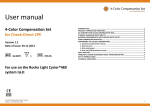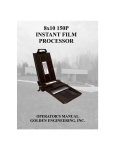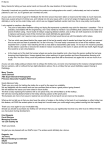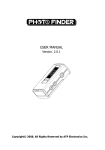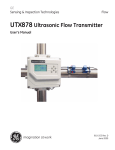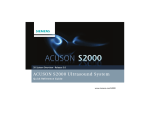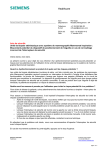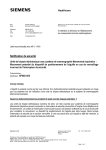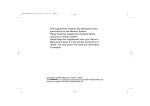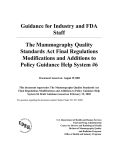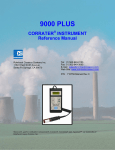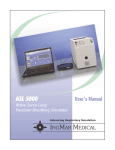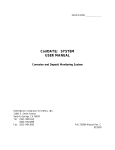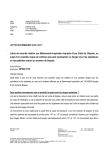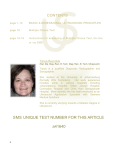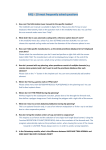Download Mammography Applications for MAMMOMAT 1000/3000
Transcript
Mammography Applications for MAMMOMAT 1000/3000 Nova Introduction This booklet is intended as an application handbook for use with Siemens MAMMOMAT® 1000 and 3000 Nova. The booklet contains advice on positioning, instructions for choice of exposure and proper positioning of the Automatic Exposure Control (AEC) detector. There are also instructions on the use of Opcomp® and Opdose®. This handbook with helpful hints and directions is a complement to the operator’s manual. It should be noted that this is not a textbook and that we make no claim of complete coverage of the subjects discussed. The responsibility for medical judgements and directions remains with the attending physician. For information on other questions relating to the operation of your MAMMOMAT 1000/3000 Nova, please refer to the Operating Instructions. 2 Contents General advice Positioning Compression AEC-detector Choice of exposure Opdose 5 6 6 8 9 10 Image quality Radiation quality Film/screen combinations Processing 13 14 15 16 Positioning Mediolateral oblique view, MLO Cranio-caudal projection, CC Lateral projection Medio lateral, ML Latero medial, LM 17 17 20 22 23 24 Specialized mammographic technique Spot compression Magnification 25 25 26 Biopsy methods Biopsy hole plate Shadow cross Stereo 27 27 27 28 3 General advice It is always important to inform the patient how the examination will be performed. It should be explained why it is necessary to compress the breast and that it will be uncomfortable for a short time. Always keep the patient under observation. If the patient is very sensitive to pain or very nervous, it is recommended that two radiographers attend in the room. Begin each setting by chosing the correct slide marker for the desired projection. With Siemens fixed markings, the risk of faulty marking is limited. The marking for a cranio-caudal projection is always found on the lateral side of the breast. 5 GENERAL ADVICE Positioning Correct positioning of the breast is extremely important. If the entire breast is not in the X-ray field, or there is something blocking the X-ray field, the whole diagnosis can be incorrect. It is also easier to apply good compression when the positioning is correct. Compression Proper and adequate compression is necessary in order to reduce the radiation dose, displace the tissue apart and avoid blurring due to motion. Inadequate compression can, for example, mean that small micro-calcifications do not appear on the X-ray image, as a result of which the patient risks getting an incorrect diagnosis. Opcomp Siemens MAMMOMAT 1000/3000 Nova are fitted with Opcomp. Opcomp senses for each individual breast when the compression force is sufficient for optimal image quality. The force can be increased but this only adds to the discomfort and does not provide any improvement in image quality. Opcomp is purely an aid. It is always the operator who decides if the compression is to stop before, after or on the Opcomp value. When using Opcomp, the foot switch is to be kept pressed down during the whole compression process. Using a pumping technique on the foot switch can result in the Opcomp indication failing to appear. 6 1 Set the maximum value for the compression force – 20 kg – unless your facility has other guidelines. Select automatic decompression (however, not when biopsies and localizations are to be performed). Apply compression until the breast is evenly and firmly compressed. Ensure that no folds form in the skin. 2 When using Opcomp: Begin by applying compression until the compression plate comes into contact with the skin (3-5 kg). Smooth out any folds in the skin. Press the foot switch all the way down, continue compression until the plate stops and the green OC lamp on the stand display is lit. Keep the patient under observation. Studies have shown that the Opcomp value on average is 9-12 kg for the CC view and 13-16 kg for the MLO view. However, some breasts may require up to 20 kg. This is not harmful. The breasts withstand this temporary deformation, but pay attention to the patient. Do not override the patients pain-treshold. More information on Opcomp can be found in the operating instructions. 7 GENERAL ADVICE AEC-detector In order to obtain the correct density on the images, the AEC detector should be moved to the densest area in the breast. Move the AEC-detector lever to the marking, which corresponds with the marking in the compression plate. Ensure that the breast completely covers the position of the AEC detector with a 2 cm margin, otherwise the chamber will be measuring air. Do not forget to return the detector to the chestwall-close position after each patient. The image on the left demonstrates the cassettes turbo release function. The text does not mention this aspect of the unit. Should this image be removed or should text be added. 8 GENERAL ADVICE Choice of exposure Both Siemens MAMMOMAT 1000 and Siemens MAMMOMAT 3000 Nova are equipped with automatic exposure control (AEC). Only the kV value is set manually. After exposure, the mAs value obtained can be read on the generator control panel. If desired, both kV and mAs can also be chosen manually. When the mAs button is first activated, a value of 100 mAs is shown on the display. Continue to press the mAs button until the desired value is shown, then make the exposure. 9 GENERAL ADVICE Opdose Siemens MAMMOMAT 1000 and 3000 Nova are equipped with an automatic exposure system - Opdose. Opdose suggests the exposure parameters depending on the thickness of the breast. Both kV and an anode/ filter combination are suggested in accordance with what has been preset for the respective thickness interval (see program table on page 12). That is, the larger the breast the more the high-energy radiation, which enables the dose and exposure time to be kept down. The user must confirm the values before an exposure is made. 1 Make sure that the “Auto” button is pressed in. Position the patient and apply the compression. The compression force must be at least 6 kg for the Opdose to activate. 10 GENERAL ADVICE 2 On the control panel, an indicator lamp will now be flashing over the program which is suggested. Confirm by pressing the program button for the suggested program. Make the exposure. It is recommended that the same program is kept for the entire examination. If you get a flashing light suggesting a different program, it is not necessary to accept this suggestion. Just make the exposure. The program used for the last exposure is maintained. As soon as you press a button which is not blinking you leave the auto-mode for Opdose. Always remember to check that the auto button is pressed in when you start with the next patient. The four programs can be set to suit the customer’s requirements on installation. Please refer to the Operating Instructions when changing program settings. You can also choose to make the exposure using a program which is set manually. On the MAMMOMAT 1000/3000 Nova, you then choose the kV value, the anode/filter combination and the film/screen combination (H/D button). 11 GENERAL ADVICE The program values as preset from the factory are, for Mo/W tube: Program Compression thickness kV-value Anode/Filtercombination 1 0 - 29 mm 26 Mo / Mo 2 30 - 44 mm 27 Mo / Mo 3 45 - 59 mm 27 Mo / Rh 4 ≈ 60 mm 26 W / Rh Program Compression thickness kV-value Anode/Filtercombination 1 0 - 29 mm 26 Mo / Mo 2 30 - 44 mm 27 Mo / Mo 3 45 - 59 mm 27 Mo / Rh 4 ≈ 60 mm 28 Mo / Rh for Mo tube: The program settings in the table are only suggestions. Each facility may choose the most suitable setting for the film/screen in use. The thickness intervals can only be changed by a service engineer. 12 IMAGE QUALITY Image quality Several factors affect the image quality. In addition to the previously mentioned factors such as positioning, compression and the position of the detector, the cooperation between the doctor, radiographer and patient is of greatest importance. 13 IMAGE QUALITY Radiation quality The radiation quality is determined by the kV value, anode material and filter. Low kV means that the image contrast increases. The kV value to be used is determined by each individual facility. Some film/screen combinations are recommended to be used with a high kV (28-30) in order to keep the contrast down. At 25 kV and large focal spot, the tube current for a Siemens mammography-X-ray tube with a molybdenum anode is 150 mA. This is an important factor, since high mA gives a short exposure time and, consequently, a reduced risk of motion artifacts. The Siemens MAMMOMAT 3000 Nova can be configured with an X-ray tube with two different anode materials - molybdenum and tungsten, plus various filter combinations of molybdenum and rhodium. At 25 kV, the tube current with tungsten (W) anode is 188 mA. This, in combination with a rhodium filter, will provide high energy radiation and also reduce dose to the patient. See the section on Opdose for instructions on use of the system. The focus size need not be selected. Fine focus will automatically be selected when the magnification table is inserted. 14 IMAGE QUALITY Film/screen combinations Mammography film and screens are made to provide high resolution and high contrast. For normal mammography, screens with the highest possible resolution should be used. Faster screens can be used for magnification, to reduce the exposure time. The resolution will be maintained through the small focal spot. Cassettes and screens should be cleaned regularly, and you should check your cassettes to ensure that the contact between film and screen is the best possible. It is important to keep all surfaces in the dark room clean (wet wiping) to avoid dust in the cassettes. 15 IMAGE QUALITY Processing Even a picture which has been properly exposed and skillfully executed can easily lose in quality in a poor development process. The film processing machine is the heart of the mammography department. Deterioration in image quality can often be traced to a disorder in the development process. Modern film processing machines can be programmed for various processing times, which means that the processing time can be adapted to mammography film. The development temperature should be approximately 35°C (95°F). Chemicals suitable for mammography film should be chosen and be mixed in small tanks, so that they always are “fresh”. Replenishment should be adapted to mammography film. The film processing machine should be inspected daily. The temperature, film speed, film contrast and film base fog should be controlled. For this purpose, a sensitometer and a densitometer are required. 16 Positioning Mediolateral oblique view MLO For routine examinations, the MLO projection is to be preferred over the 90° lateral projection. More of the breast tissue can be seen in the upper outer quadrant and the axilla. Furthermore, it is easier to carry out the application with this setting. MLO CC Criteria: The pectoral muscle should be depicted obliquely from above and be visible down to the level of the nipple or further down. The shape of the muscle should be depicted weakly convex as a sign that the muscle is completely relaxed and medially prominent. The compression should be proper over the whole image area. The nipple should be depicted in profile and a small stomach fold should be visible as a sign that the whole breast is reproduced. 17 POSITIONING 1 Set the angle for the desired projection (30°- 60°). It is best to adapt the angle to each patient. The object table should be parallel with the pectoral muscle. Many clinics want to use the same projection angle for all patients, in order to be able to reproduce the image on the next occasion. 2 Be sure to adjust the height so that the top edge of the object table is on a level with the axillary fold. 18 POSITIONING 3 Place the patient’s hand on the lower part of the handle. Turn the patient 45° or more in towards the stand. Ask the patient to stand steadily and not to move her feet. Instruct the patient to lift her elbow but still keep her hand in the same position. Ask the patient to bend slightly forward, then take hold of the lifted arm and the breast from below. At the same time as you move the patient in towards the object table, draw the breast parenchyma medially. Ensure that the patient relaxes and ask her to lower her shoulders and at the same time roll them forward. Draw the breast forward at the same time as you apply compression and hold on the clavicle with your other hand so that the compression plate is just clearing the clavicle. When the compression is sufficient, using Opcomp or your own selection, make sure that nothing blocks the field of the intended image. 4 Make sure the patient is at ease and ask her to stand absolutely still, before you leave her to make the exposure. 19 POSITIONING Cranio-caudal projection CC MLO CC Criteria: The whole breast parenchyma should be depicted. The fatty tissue closest to the breast muscle should appear as a dark stripe on the X-ray and behind that it should be possible to discern the pectoral muscle. The nipple should be depicted in profile. 1 Lift the breast approximately 2 cm and adjust the height so that the object table touches your hand. 20 POSITIONING 2 Stand on the medial side of the breast which is to be X-rayed (or behind the patient). Ask the patient to turn her head in your direction (good to have eye contact). Take hold of the patient’s back and shoulder in order to press her closer to the table. Then with your other hand, take hold under the breast and lay it on the table. Draw the breast somewhat towards you so that the lateral side is turned forwards. Grasp the breast with a grip from the sides so that you can guide it better. Bear in mind that you should not draw the lateral side forward so much that the medial side is lost. 3 Apply compression while keep- ing an eye open for folds on the lateral side. Use your hand on the patients shoulder to stretch the skin. Ensure that nothing blocks the X-ray field. 4 Make sure the patient is at ease and ask her to stand absolutely still, before you leave her to make the exposure. 21 POSITIONING Lateral projection The lateral projection can be taken either from the medial side (mediolateral, ML) or from the lateral side (lateromedial, LM). If no oblique projection is taken, the mediolateral projection may be preferable since the lateral side of the breast, where pathological changes are most commonly found, is then closest to the film. However, if you want to include as much as possible of the medial side, then the LM projection should be chosen. Criteria: The pectoral muscle should be depicted as a narrow light band on at least half of the picture. The nipple should be depicted in profile and a clear stomach fold should be visible under the breast. 22 90° ML mediolateral POSITIONING Medio lateral ML 1 Set the X-ray tube in a 90° lateral projection. Ensure that the correct slide marker is used. 2 Set the height to the axillary fold. 3 Ask the patient to put up her arm along the object table and stretch it well forward. 4 Grasp the breast from below and draw it out while applying compression. Place your other hand on the patient’s back and press her in towards the stand. 5 If the other breast blocks the field of the view, ask the patient to keep it out of the way. You may wish to help her with this to avoid unnecessary turning. Pull the patient’s hand carefully to the side so that only her fingertips are holding the breast. A wide paper plaster can also be used – tape from the sternum and fix it, after drawing the breast back, onto the patient's back. 6 Make sure the patient is at ease and ask her to stand absolutely still, before you leave her to make the exposure. 23 POSITIONING Latero medial LM 90° LM lateromedial 1 Set the tube in a 90° lateral projection. Ensure that the correct slide marker is used. 2 Set the height to the uppermost point of the sternum. Position the patient with the object table between her breasts. 3 Ask the patient to lift her arm and place her hand on the handle while keeping the elbow lifted. Then ask the patient to place the point of her chin as far forward as possible on the edge of the object table. 4 Grasp her breast from below and draw it outwards. At the same time as you apply the compression, the patient must be pressed in towards the table. Take care to ensure that her arm is not squeezed. 5 Ensure that nothing blocks the X-ray field. Make sure the patient is at ease and ask her to stand absolutely still, before you leave her to make the exposure. 24 SPECIALIZED MAMMOGRAPHIC TECHNIQUES Specialized mammographic technique Spot compression Spot compression images are valuable when improved compression is desired over a small area and overlapping structures need to be separated. Since scattered radiation is reduced with this technique, it is possible to obtain high contrast and detailed images. 1 Set the tube at the angle desired. Choose the correct marker. Mount the spot plate and corresponding aperture. Sometimes the spot view can be obtained without an external aperture, or with a larger aperture (axilla) if you want to visualize the surrounding area. 2 Measure accurately (use a ruler) on the X-ray image where the lesion is to be found. Measure from the nipple straight in and then at right angles to the area of interest. Transfer the measurement to the breast and make a small crossmark. 3 Inform the patient that it may feel more unpleasant with the spot plate. Compress thoroughly and ensure that the cross lands right under the plate. Make sure that no folds in the skin are formed. 4 Tell the patient to stand absolutely still and leave her to make the exposure. Note: Opcomp shall be neglected when spot-compression plates are used. 25 SPECIALIZED MAMMOGRAPHIC TECHNIQUES Magnification When making exposures with a magnification table, the same positioning methods are used as for normal images or spot compression images. There are two different compression plates available, a flat plate used without a aperture and a spot compression plate with a corresponding aperture. Take care to compress thoroughly. Ask the patient to hold her breath. It is useful to practice this procedure in advance. “Breath in, breath out and hold your breath”. Since we use a smaller focal spot in magnification mode, the exposure times are longer and therefore it is of utmost importance that the compression is as firm as possible and that the patient holds her breath. Note: Opcomp shall be neglected when magnification tables are used. BIOPSY METHODS Biopsy and localization methods Mammography is a superior method for early detection of breast cancer. Many pathological changes that are discovered are so small that it is not possible to carry out palpation guided biopsies. X-ray guided biopsies can be carried out in various ways and with different means. Biopsy hole plate A hole plate (perforated compression plate) with a coordinate system helps the physician when making hand controlled biopsies. Make an exposure in a CC projection using a biopsy hole plate. Evaluate and use the coordinates to calculate where the needle should be inserted. To check the depth of the needle, make a right angle exposure (compress carefully) with the needle remaining in the breast. Evaluate and make necessary adjustments. Carry out the biopsy procedure. Remember to switch off the automatic decompression. Shadow cross A shadow cross attachment with a coordinate system helps the physician when making hand controlled biopsies. A detailed step by step information on how to use the shadow cross is found in the separate Operating Instructions “Biopsy attachment with shadow cross”. 27 BIOPSY METHODS Stereo On the Siemens MAMMOMAT 3000 Nova, there is the possibility of connecting up a stereo biopsy attachment. With the aid of this stereo attachment, biopsies can be performed both with fine needle and core-gun technique. Instructions on how the attachment is mounted and used is described in the separate Operating Instructions “Stereotactic Biopsy Attachment”. The following are some advices on how the examination can be made easier for the patient. 1 Inform the patient about the procedure. Explain that the examination can take time (at least 20 minutes) and that she must sit still subject to compression the whole time. Explain that the greatest source of unpleasantness is not the actual needle-puncture but rather the sitting position. This procedure can also be carried out with the patient recumbent. Show the patient the angular movement and how the cassette is moved. 2 Ask the patient to sit in the examination chair. The chair must be height-adjustable and be provided with lockable wheels and adjustable arm supports. Start from as high a level as possible of the chair (facilitates the working position). A foot ring on the chair, or a footstool, improves the sitting position. Ask the patient to check that she is sitting comfortably. 28 BIOPSY METHODS 3 Position and compress. Note the compression thickness so that you can make an adjustment if the compression value changes. Mark on the breast with a felt-tip pen the inner corners of the compression plate. In this way, you have control over the positioning and you will notice at once if the patient has moved. 4 Perform stereo exposures and evaluate in accordance with the Operating Instructions for “Stereotactic Biopsy Attachment”. 5 Never leave the patient on her own. Keep eye contact and stand close, a warm hand on her shoulder can be supportive. Explain the procedure as it progresses. 29 On account of certain regional limitations of sales rights and service availability, we cannot guarantee that all products included in this brochure are available through the Siemens sales organization worldwide. Availability and packaging may vary by country and is subject to change without prior notice. Some/All of the features and products described herein may not be available in the United States. The information in this document contains general technical descriptions of specifications and options as well as standard and optional features which do not always have to be present in individual cases. Siemens reserves the right to modify the design, packaging, specifications and options described herein without prior notice. Please contact your local Siemens sales representative for the most current information. Note: Any technical data contained in this document may vary within defined tolerances. Original images always lose a certain amount of detail when reproduced. For accessories please refer to: www.siemens.com/medical-accessories Headquarters Siemens AG, Medical Solutions Henkestr.127, D-91052 Erlangen Germany Telephone: +49 9131 84-0 www.siemens.com/medical Contact address Siemens AG, Medical Solutions Special Systems Allee am Röthelheimpark 2 D-91052 Erlangen Telephone: +49 9131 84-0 © 2004, Siemens AG Order no. A91100-M1600-C924-1-7600 Printed in Germany GP 65924 WS 07042.5






























